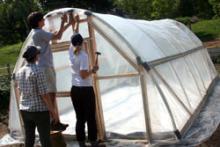You are here
Ragweed Experiment Underway

A major component of a 3-year allergenic plant study--funded by the EPA and led by HF ecologists Kristina Stinson and David Foster, with UMass professor Christine Rogers--is in its final stages of build-out in the Harvard Forest experimental garden. A team of staff and summer students have contributed to the construction of 14 hoop houses, which will each house 1,248 ragweed plants grown from seeds collected in New York City, Burlington, and Boston. Valves in the hoop houses will expose the ragweed plants to a range of carbon dioxide levels as they grow. The plants should begin producing pollen in August. Prior research shows that ragweed plants respond strongly to increases in carbon dioxide by changing the abundance and potency of pollen they produce. The hoop house data will be augmented by data collected this year from 24 native ragweed populations across Massachusetts, from Boston to the Berkshires. The project's final output: maps and models of allergy risk factors as a function of changing climate patterns in the Northeast.
Hear from the students who worked on the project in summer 2011: Ragweed in a Changing Climate
Learn more scientific details about the experiment: Predicting ragweed allergy hotspots in New England

